多发性硬化症小鼠模型中miR-145的调节:一种减轻炎症和变性的有希望的方法
IF 5.6
2区 医学
Q1 NEUROSCIENCES
引用次数: 0
摘要
多发性硬化症(MS)是一种进行性中枢神经系统(CNS)炎症性疾病,其特征是髓磷脂丢失,损害神经功能。目前的治疗方法不能阻止疾病进展或防止髓鞘和轴突变性。在这项研究中,我们探讨了miR-145缺失在模拟MS病理的实验性自身免疫性脑脊髓炎(EAE)小鼠模型中的影响。在疾病的发病和慢性阶段,miR-145的缺失降低了临床严重程度,并显著减少了腰椎脊髓的免疫细胞浸润。此外,miR-145缺失改变了关键炎症基因的表达,并调节了整个EAE的星形细胞活性。值得注意的是,在EAE小鼠中,使用靶向miR-145的反义寡核苷酸(ASO)进行急性治疗可降低miR-145水平,并导致疾病严重程度降低、免疫细胞浸润减少和调节性T细胞增加。此外,miR-145缺失减轻了轴突和髓鞘变性。我们的研究结果表明,靶向miR-145的ASOs可能提供一种有希望的治疗策略,可以解决多发性硬化症的炎症和退行性成分。本文章由计算机程序翻译,如有差异,请以英文原文为准。

Modulation of miR-145 in a mouse model of multiple sclerosis: A promising approach to attenuate inflammation and degeneration
Multiple sclerosis (MS) is a progressive inflammatory disease of the central nervous system (CNS) marked by myelin loss, which impairs nerve function. Current therapies fail to halt disease progression or prevent myelin and axonal degeneration. In this study, we explored the impact of miR-145 loss in a murine model of experimental autoimmune encephalomyelitis (EAE), which mimics MS pathology. Loss of miR-145 reduced clinical severity and significantly decreased immune cell infiltration in the lumbar spinal cord during both the onset and chronic stages of the disease. Additionally, miR-145 loss altered the expression of key inflammatory genes and modulated astrocytic activity throughout EAE. Of significant interest, acute treatment with an antisense oligonucleotide (ASO) targeting miR-145 decreased miR-145 levels and led to reduced disease severity, decreased immune cell infiltration, and an increase in regulatory T cells in EAE mice. Moreover, miR-145 deficiency mitigated axon and myelin degeneration. Our findings suggest that ASOs targeting miR-145 may offer a promising therapeutic strategy, addressing both inflammatory and degenerative components of MS.
求助全文
通过发布文献求助,成功后即可免费获取论文全文。
去求助
来源期刊

Neurobiology of Disease
医学-神经科学
CiteScore
11.20
自引率
3.30%
发文量
270
审稿时长
76 days
期刊介绍:
Neurobiology of Disease is a major international journal at the interface between basic and clinical neuroscience. The journal provides a forum for the publication of top quality research papers on: molecular and cellular definitions of disease mechanisms, the neural systems and underpinning behavioral disorders, the genetics of inherited neurological and psychiatric diseases, nervous system aging, and findings relevant to the development of new therapies.
 求助内容:
求助内容: 应助结果提醒方式:
应助结果提醒方式:


